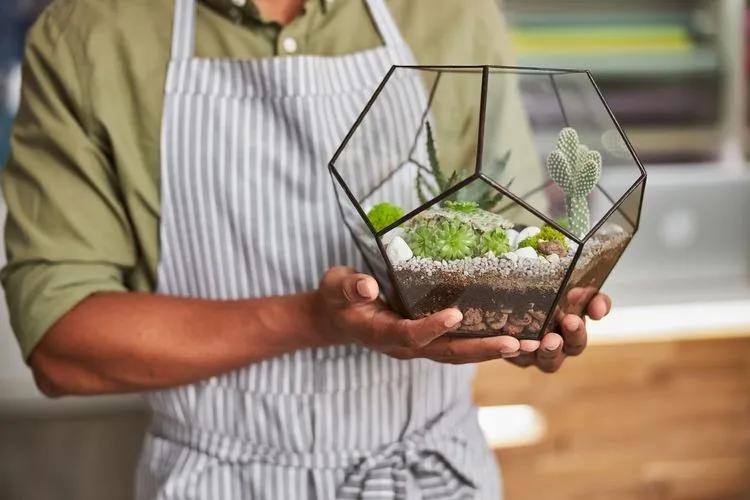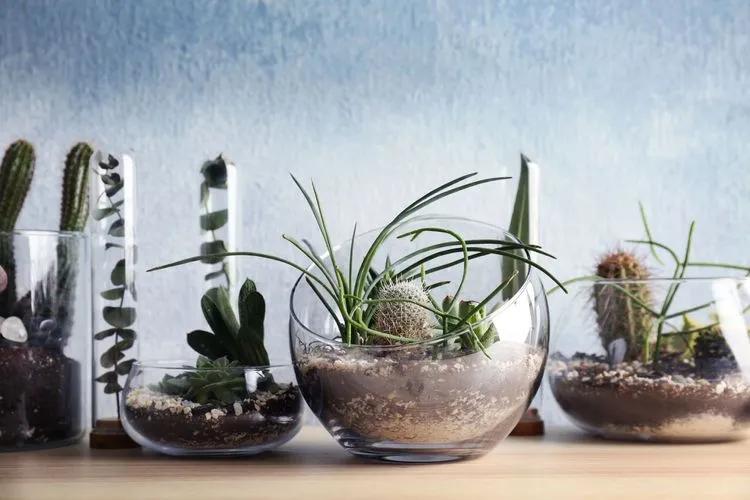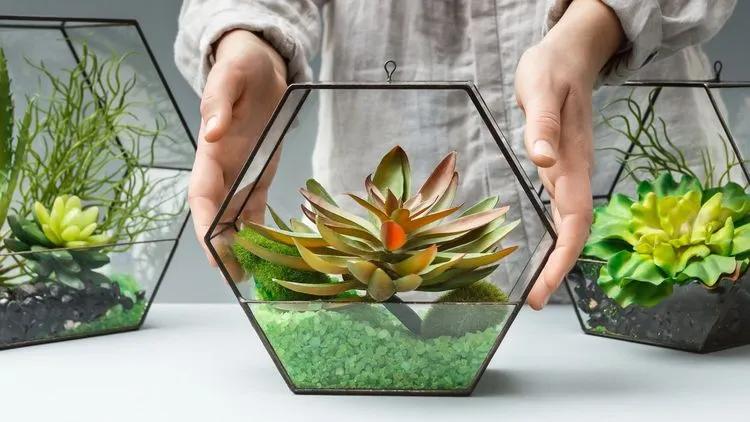How to diversify your houseplants collection? While enjoying a hobby of planting remains actual for years, methods of decoration of your green pets may vary. Lately, ordinary pots, even the prettiest ones, have become a little too banal. If you are tired of them, try to make your own transparent and super stylish florarium! How? Read our guide to learn all the details of creating a unique garden in a bottle.

What is a Florarium?
A florarium or terrarium for plants is a small container inside which plants grow. We advise making it of glass or dense translucent plastic or combining wooden models with transparent inserts. The florarium has a narrower opening at the top or side, often covered by a lid, to maintain the microclimate inside the container. It is recommended to use special containers for growing plants and all kinds of glass bottles, jars with lids, large wine bottles, bowls with narrowed holes, laboratory flasks, or any other transparent vessels.
The general principle of the florarium is to maintain a more or less stable level of humidity and temperature. Special equipment for heating and lighting makes the florarium independent of natural light and heat sources. All this allows you to grow the most bizarre plants that require unusual conditions and care.
Aquariums and terrariums for turtles, snakes, and other animals can also be used. You can also use large round vases, bowls, and even regular glass cups or glasses. Such containers are open, so there is no separate microclimate in them. As a result, you need to monitor the temperature regime and regularly water and spray the plants, like ordinary potted greens.
The compactness of florariums is one of their significant advantages, especially for small apartments and small window sills. The variety of plants in the terrarium looks very stylish and unusual, especially against the background of standard potted plants.

Types of Florariums
The florarium repeats the natural habitat of the selected plants. Therefore, you need to rely on the climatic zone and the habitat — since the plants will grow in the same conditions, they must match each other in terms of lighting, humidity, and temperature. Do not plant wet forest Ferns and desert Succulents in the same container. Each type of florarium needs its watering, ventilation, and temperature regime so that the entire plant composition grows safely.
Tropical Rain Forests
You can make the composition using tropical rainforest plants such as those found in the Amazon, the rainforests of Southeast Asia, or the Atlantic equatorial coastal forests. Even in a tiny container, you can recreate a semblance of multi-tiered jungle forests using plants of different heights. The composition's foreground should remain open so you can see all the tiers.
Choose plants with similar soil requirements, moderate growth, and high moisture requirements. For tropical plants, it is preferable to use a soil mixture with an admixture of coarse sand, leafy soil, and peat. To maintain high humidity, pour a small glass of water into the vessel and decorate it or pull a small snag out of the water.

Semi-Desert
If you have neither the time nor the inclination to monitor the humidity in the terrarium by frequently watering and feeding the soil, there are many suitable plants! Pay attention to Succulents, desert, and semi-desert dwellers. You can choose any Cactus, Echeveria flower, and so on. They all need a little water as they hold moisture in the stems. The root system of such plants is tiny and not very developed, so they will thrive in transparent containers where not so much space is provided.
You can form the soil from coarse and fine sand, pebbles, and even ceramic fragments. However, make sure your succulents are getting enough sunlight — this is a desert, right?

Get Started
To make a florarium with your own hands, you will need:
- Glass container with or without lid (aquarium, vase, jar)
- Soil that matches the preferences of the chosen plants
- Drainage (sand, small pebbles, expanded clay, broken brick)
- Activated charcoal
- Plants
- Decorative elements of your choice
- Tools (spatula or spoon, long tweezers, sprayer, watering can, scissors).
Step 1
Prepare a container for planting. Wash it well and pour hot water over it, but ensure it's not boiling to prevent the glass from cracking. Fill in a drainage layer 3-4 cm high. This can be expanded clay, coarse sand, pebbles, decorative stones for the aquarium, seashells, and many other variants — be creative!
Step 2
Place activated charcoal on top of the drainage. This is necessary to absorb harmful chemicals from the water, preventing mold and mildew from developing. By the way, it is recommended to water and spray the plants in the terrarium with filtered water.
Step 3
Pour 5-8 cm of moist soil on top. Crushed charcoal can be mixed with the soil and not laid in a separate layer. Sieved sand can be used for compositions with desert plants, and we recommend a ready-made substrate for tropical plants. For decorative purposes, soil layers can be alternated with thin layers of colored sand.
Step 4
Level the soil, and use a spoon to make small indentations for the plants. Remove the plants from the pots carefully, and clean their roots. Using tweezers, gently plant them in the prepared substance, and sprinkle them with water. Make sure that large leaves do not touch the sides of the container because, otherwise, condensation may make them rot. Gently spray the planted plants with a sprayer. If the soil is not wet enough, pour water from a thin-nosed watering can. Add decorative elements.

And that’s all! As you see, making a florarium is not challenging and even fun. However, it will impress your guests and will definitely refresh any interior — from your room to your office. Try it yourself with tropical Orchids, Succulents, Mosses, Tillandsias, Cacti, and many other cute green pets.
